The Sun
The sun is a yellow dwarf star. It is a star because it produces light and energy by means of nuclear fusion converting hydrogen to helium. It is the heat and light generated from the sun that makes life on Earth possible.
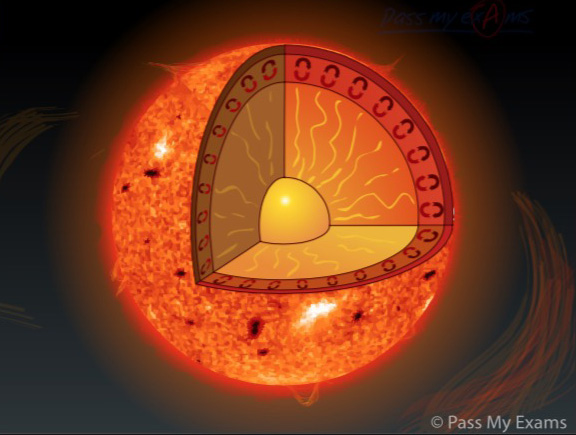
The sun lies in the centre of the solar system and contains more than 99% of the solar system’s mass. It is the gravitational pull generated from it immense mass that keeps all the planets, dwarf planets, asteroids and all other bodies in orbit around it.
The source of the vast amounts of solar energy produced by the sun is through thermo-nuclear reactions. The high pressures and temperatures within the sun allow for nuclear fusion to take place, a process which converts the hydrogen in the sun to helium with the release of a large amount of energy. The energy released from these nuclear reactions produce an outward pressure which counteracts the inward force of gravity the sun faces from its immense mass. At the current stage of the sun life these forces are balanced and it is for this reason that the sun neither collapses under its own weight nor expands.
The animation below describes the detailed structure of the Sun:
The Core
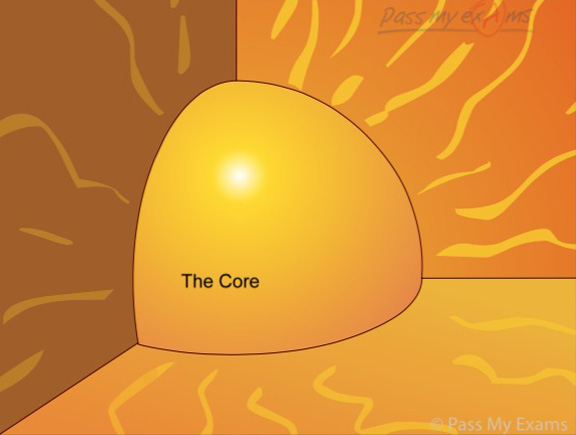
The sun’s core is made up of a very hot and dense mass of atomic nuclei and electrons. The extremely high temperatures in the core (approximately 15 million degrees Celsius) and enormous pressures allow for similarly charged protons in atomic nuclei to overcome their forces of repulsion and fuse together giving rise to nuclear fusion reactions. Thermonuclear reactions in which nuclei collide to form new heavier nuclei are called fusion reactions. Nuclear fusion within the sun’s core involve four Hydrogen nuclei fusing together to form one Helium nucleus. The mass of the Helium nucleus is approximately 0.7% less than the combined mass of the four Hydrogen nuclei. This 0.7% mass difference is converted to energy. As millions of tons of Hydrogen undergo fusion within the suns core every second therefore millions of tons of energy are created.
Radiative Zone
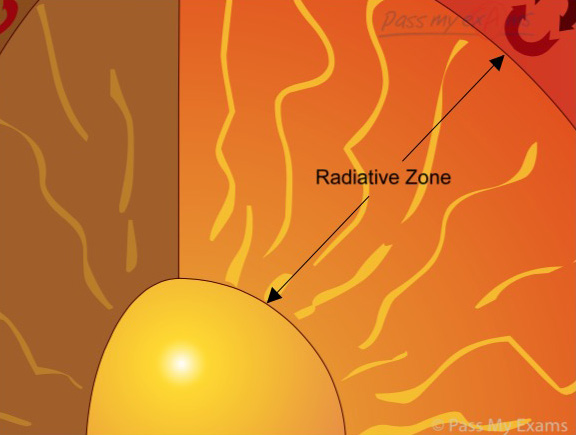
This region gets its name from the mode of energy transfer. Energy created from the fusion reactions in the core contain a large amount of gamma rays which pass through the dense Radiative zone. Here they collide with atoms which absorb the energy and in the process radiate the energy as an electromagnetic wave of different wavelength.
Convective Zone
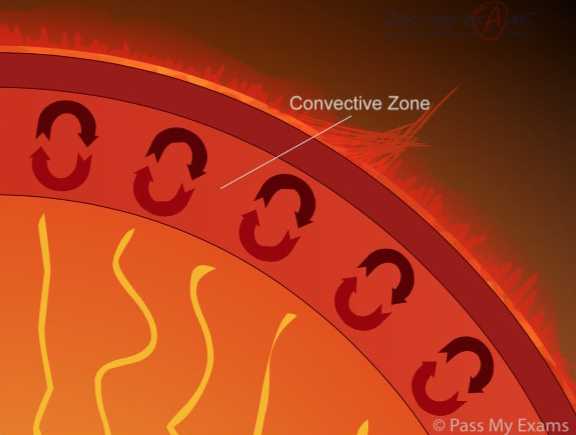
The convective zone makes up about 30% of the suns interior. It is a cooler region that surrounds the radiative zone. Here the energy is transported to the surface of the sun by convection currents. Hot gases bubble up from within the convection zone and transfer the energy to the surface where the gases become cooler and denser and sink back to the bottom and the cycle is repeated.
Photosphere
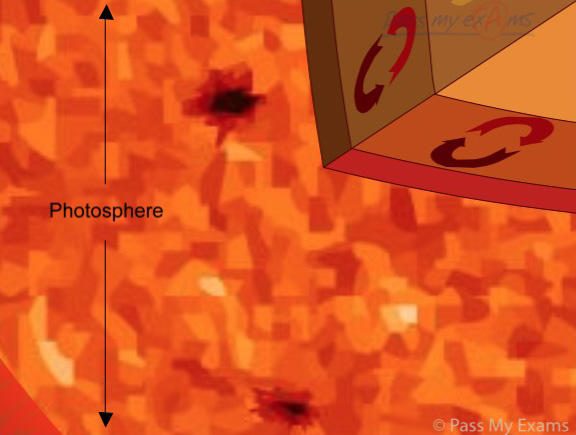
Photosphere means “sphere of light”. It is the lowest level of the sun’s atmosphere and is the visible surface of the sun seen from Earth. It is at the photosphere that the energy finally escapes from the sun and so it is significantly cooler than the interior with an approximate temperature of 6000°C. The surface of the photosphere is covered with a pattern of bright grainy marking called granulations. These grainy markings are the result of convection currents that bring hot gases up from the interior. These granules continually form and disappear as hot gases flow out and measures several hundred miles across. Dark patches called sunspots can also be seen on the photosphere.
Sunspots
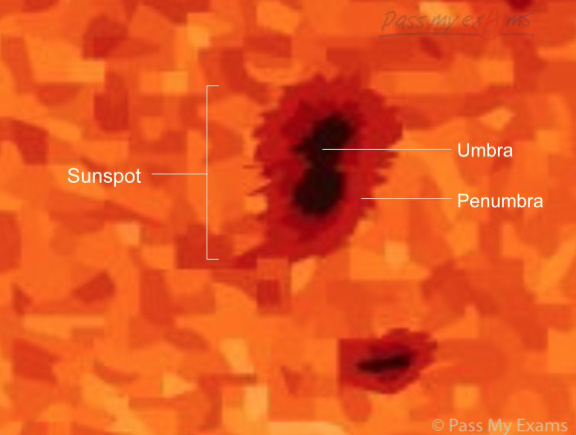
Sunspots appear on the photosphere as dark patches. Sunspots are areas where strong magnetic fields interfere with the normal convection currents which bring the energy to the surface. The magnetic field is caused by the movement of gases inside the sun. Sunspots appear in pairs or groups of pairs with opposite magnetic polarity. The strong magnetic field lines from the interior of the sun exit the surface travel through one spot loop through the solar atmosphere and re-enter the photosphere through the other spot. The reason sunspots appear as dark patches is because they are about 2000°C cooler than the photosphere around them. This means they are still very hot with a temperature of about 4000°C. A typical sunspot has a dark circular centre, called the umbra, surrounded by a lighter area called the penumbra.
Flares
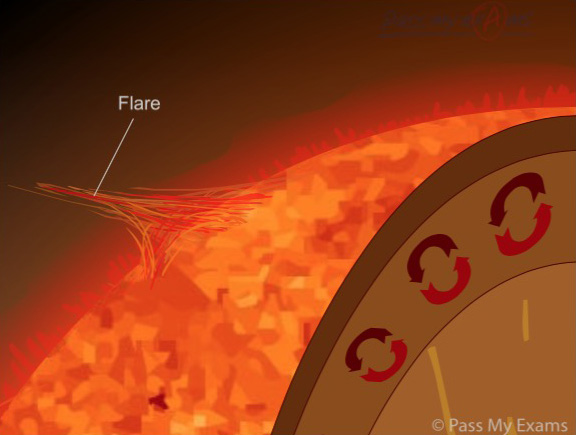
A solar flare is a sudden and violent discharge of energy in the chromosphere associated with sunspots. The flares usually form rapidly and can last for anytime between a few minutes to a few hours. They release a huge amount of energy and shoot out energetic charged particles into space, but the majority of the radiations are in the form of electromagnetic waves of different wavelengths including gamma and x-rays.
Prominences
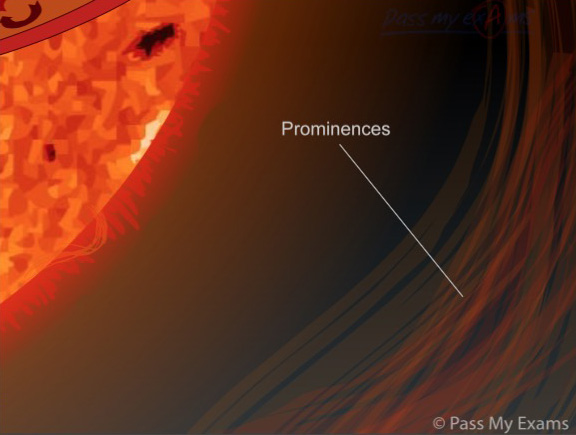
Prominences are huge clouds of ejected gases which rise thousands of kilometres above the photosphere and orient themselves along the magnetic fields associated with sunspot pairs. Prominences can last for many weeks or even months if they form at boundaries between large scale magnetic fields.
